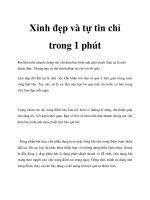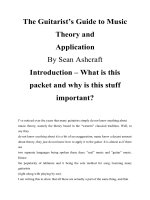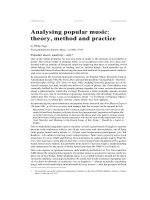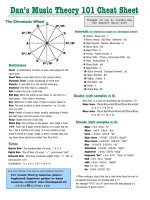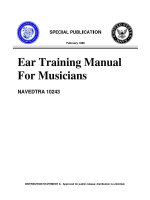Music Theory FundamentalsSection 1.6 pptx
Bạn đang xem bản rút gọn của tài liệu. Xem và tải ngay bản đầy đủ của tài liệu tại đây (218.9 KB, 2 trang )
LearnMusicTheory.net High-Yield Music Theory, Vol. 1: Music Theory Fundamentals
18
Section 1.6
C O M P O U N D A N D A S Y M M E T R I C M E T E R
Beats in compound time signatures divide into three division notes, not
two. The top number indicates the number of division notes per measure.
The bottom number indicates the division rhythmic value (not the beat
unit). It takes three division notes (not two) to make one beat.
A time signature with 6, 9, 12, or 15 on top is compound. To get the
number of beats, divide the top number by three. The beat unit is a dotted
rhythmic value one larger than the bottom number; sixteen on the bottom
means a dotted-eighth beat unit, eight on the bottom means a dotted
quarter, and so on. Compound time signatures can be duple, triple,
quadruple, or even quintuple (five beats).
Sometimes tempo can make a normally compound time signature into a
simple time signature, or a normally simple time signature into a
compound one. This is especially common if the top number is six or three.
6
8
&
1 2
= 6 division notes
= e is division of beat
One beat = e + e + e = q.
2 beats (Duple)
6
8
Ϫ
œ œ œ
Ϫ
œ œ œ
9
16
12
8
&
1
= 9 division notes
= x is division of beat
One beat = x + x + x = e.
3 beats (TRIPLE)
9
16
2 3
&
1
= 12 division notes
= e is division of beat
One beat = e + e + e = q.
4 beats (QUADRUPLE)
12
8
2 3 4
œœœ
Ϫ
j
œœœ
Ϫ
j
œœœ
Ϫ
j
Ϫ
œ œ œ
Ϫ
œ œ œ
Ϫ
œ œ œ
Ϫ
œ œ œ
Very fast Very slow
6
4
6
4
&
1
= 6 division notes (2 beats)
= q is division of beat
One beat = q + q + q = h.
Compound Duple
6
4
2
OR &
1 2
6
4
= 6 beats
= q is beat unit
Simple Sextuple
3 4 5 6
œ
˙™
œ œ œ
˙™
œ œ
œ
œœ
œ
œœ
œ
œœ
œ
œœ
œ
œœ
œ
œœ
Compound time
signatures
Decoding
compound time
signatures
Tempo and Meter
Chapter 1: Music Notation
19
Asymmetric time signatures have a mixture of two and three-part beat
divisions. The top number indicates the number of division notes per
measure (often 5, 7, or 11, but varies). The bottom number indicates the
division rhythmic value (not the beat unit). The beaming indicates beat
groupings for individual beats.
For time signatures in asymmetric meter, beats with three division notes
will be longer than beats with two division notes. The length of the division
note value, not the beat, must remain constant. In the left example below,
the eighth note pulse remains constant, while in the right example the
quarter note pulse remains constant. See 1.7 Tuplets/Grouplets for an
explanation of the triplets in the right example.
Music in compound meter may also include an anacrusis. If so, the last
measure will be shortened by the amount of the anacrusis, as in simple
meter. Stress patterns for duple, triple, and quadruple compound time
signatures match those given at the end of 1.5 Time Signatures in Simple
Meter.
Simple time signatures are simple: the top number is the number of beats,
and the bottom is the beat unit. Compound time signatures nearly always
have 6, 9, 12, or 15 on top, indicating the number of division notes; the
bottom number indicates the division rhythmic value. Asymmetric
signatures have beats with unequal lengths. Like compound time
signatures, asymmetric time signatures indicate the rhythmic value for one
beat division, not the beat unit.
5
8
7
16
11
8
&
1
= 5 division notes
= e is division of beat
2 beats (DUPLE)
5
8
2
&
1
= 7 division notes
= x is division of beat
3 beats (TRIPLE)
7
16
2 3
&
1
= 11 division notes
= e is division of beat
4 beats (QUADRUPLE)
11
8
2 3 4
Ϫ
œœœ
œ
œœ œ œœ
Ϫ
j
œœ
œ
j
œœ
œ
j
Ϫ
œœœ
Ϫ
œœœ
Ϫ
œœœ
œ
œœ
5
8
2
4
&
1 2
sounds
different than
&
1 2
3
Ϫ
œ œ œ
œ
œ œ
œ
œ œ œ
œ
œ œ
Asymmetric time
signatures
Performing
asymmetric time
signatures
Anacrusis and
stress patterns in
compound meter
Summary of time
signatures and
meter


